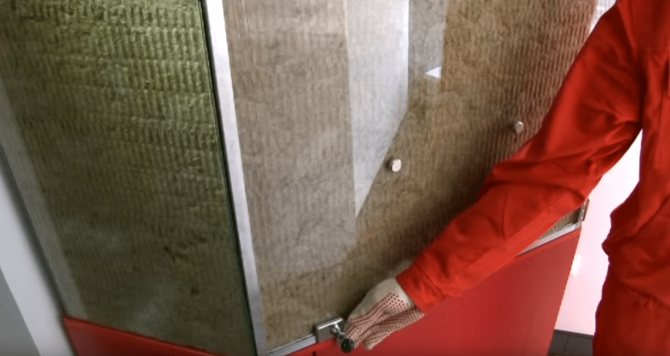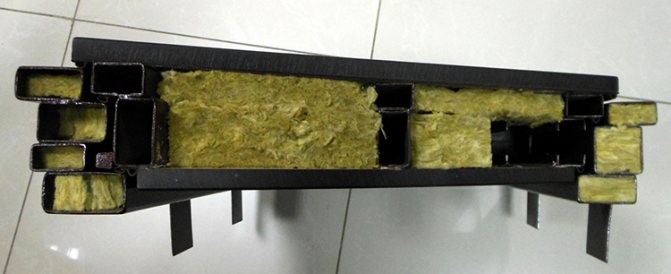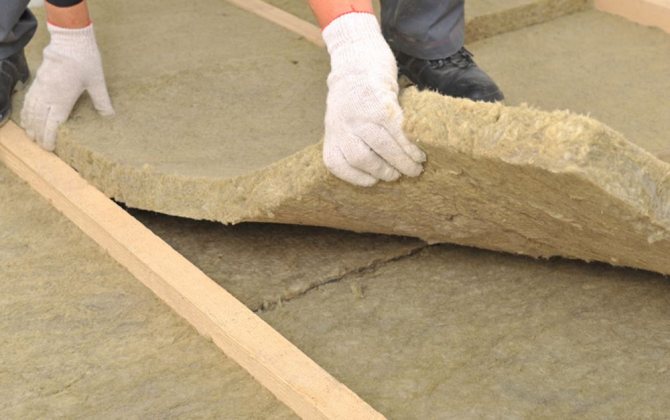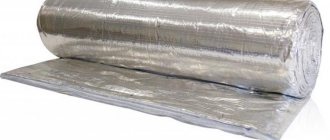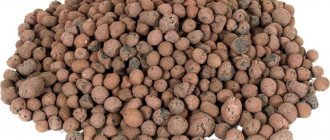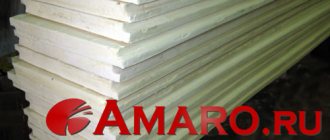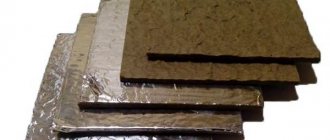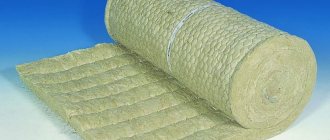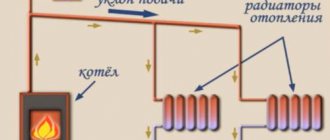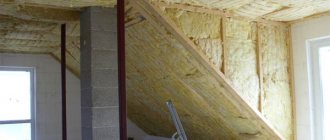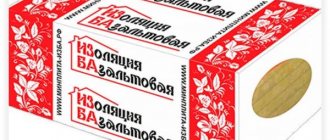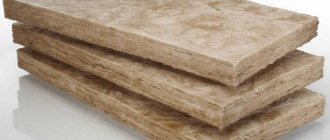In order to keep the house warm longer in winter, and to keep the coolness in summer, people insulate their houses. There are many materials for this, but the best and most popular at the moment is basalt mineral wool. In this material, fibers are randomly located, which are of mineral origin. Therefore, the material was named mineral wool. Now let's figure out what its charm is.

There are three types of mineral fiber insulation:
- slag;
- glass wool;
- basalt wool.
Everyone knows that air is the best insulating material. He is able to provide comfortable living in any room. And the task of any insulation is to restrain it, while making it static, and besides, to leave it dry. After all, if moisture penetrates into the insulation, then it will not be able to fulfill its functions to a greater extent.


Nowadays, basalt wool insulation is so common because it is able to maintain air retention, leaving it dry better than all other materials. What makes it so effective.
Slag wool is made from blast furnace waste. Its color is gray-brown.
Glass wool is made from sand, soda, dolomite, limestone, borax, and broken glass.
What is basalt wool made of?
Consider the technical characteristics of basalt wool, as well as the ways of its application. Among all similar insulating materials, basalt wool has the lowest thermal conductivity. In addition, it is non-combustible, vibration-resistant, and also hydrophobic. It can be of different density, which allows it to be elastic or, conversely, rigid. This quality makes basalt wool versatile.
Basalt wool (technical characteristics of its fiber) allows you to create materials of any strength, shape and size. All these advantages are ideal for absolutely any job.
Characteristics and application of mineral wool insulation
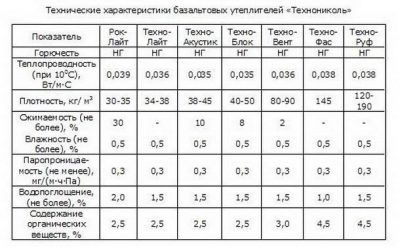

Minvata is used for thermal insulation of buildings of all types, heating mains, pipelines. The material is produced on the basis of natural components - rocks with the addition of a synthetic binder. The insulation is characterized by high strength, low thermal conductivity, simple installation.
Below is a detailed description and characteristics of mineral wool for insulation.
Mineral wool Is a heat-insulating material with a fibrous structure, which is produced from mineral raw materials from the bowels of the earth using a synthetic binder.
The raw materials are rock melts.
Mineral wool has the following varieties:
- Basalt wool (stone) - made from molten igneous rocks
- Slag - made from blast-furnace slag melt
- Glass - made of glass melt
Other names of the material are mineral wool, mineral wool insulation.
Composition and technology of production of mineral wool
The composition of the mineral wool insulation includes silicate melts of blast furnace slags, igneous and sedimentary rocks. Materials from the earth's crust make up up to 80% of its composition. The combination and percentage of occurrence of one or another raw material depends on the type of mineral wool.
Stone wool in its composition contains gabbro or diabase, blast-furnace slags, charge. Mineral components - clay, dolomite, limestone - are added to it as impurities to increase the fluidity of the material. Their content reaches 35%.The binder is a substance based on formaldehyde resin, which is much less in the composition - 2.5-10%.
Slag wool also has a fibrous structure. It is produced from blast-furnace slag - waste of the metallurgical industry when iron is smelted in blast furnaces. The fibers of the material are small - 4-12 microns thick, up to 16 mm long.
The raw materials for the production of glass wool are sand, dolomite, soda, limestone, borax, glass breakage.
The percentage of raw materials is selected so as to ensure the maximum quality of the future fiber - hydrophobicity, chemical neutrality, durability, high thermal insulation performance, and resistance to stress.
The production of mineral insulation begins with the melting of a mixture of raw materials. To do this, they are loaded into baths, cupolas or shaft smelting furnaces. The melting temperature is strictly observed, which is in the range of 1400-1500 C, since the length and width of the fibers depend on the degree of melt viscosity, therefore, the technical and thermal insulation properties of the mineral wool.
The mixture, brought to the desired viscosity, is then placed in centrifuges with rollers rotating at more than 7000 rpm. They tear it into thin fibers. In the centrifuge, the fibers are coated with a binder. After that, a powerful stream of air throws them into a special chamber, in which they form a carpet of the required size.
Then the material goes to a corrugating or lamellar machine, where it is given the required shape and volume. After that, he is exposed to high-temperature exposure in a heat chamber. In this case, the binders undergo polymerization, and the cotton wool takes on its final volume and shape. The final heat treatment forms the strength characteristics of the insulation. The finished mineral wool is cut into blocks and packaged.
The concept of "mineral wool" and the materials related to it are defined in GOST 31913-2011 (international standard ISO 9229: 2007).
Places of application of basalt wool of different structure
Soft basalt wool is used where no load will be exerted on the thermal insulation. It is ideal for well masonry or ventilated facades with minimal airflow in ventilation gaps. Typically, these buildings do not exceed 4 floors.
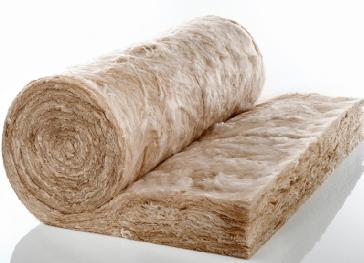

The semi-hard look is basalt wool, the technical characteristics of which allow it to be used in high-rise buildings. The use of such a material shows itself perfectly in ventilated facades, where the speed of air flows is unlimited. In addition to these advantages, basalt wool is used to provide thermal, fire and sound insulation of air ducts.
Rigid basalt wool is used in places where a load will act on the insulation. Several years ago, the decision to use this material anywhere was made based on the density of its structure. However, today this technique is outdated. At the moment, there are many basalt wool heaters, which, even with a minimum density, can easily withstand significant loads.
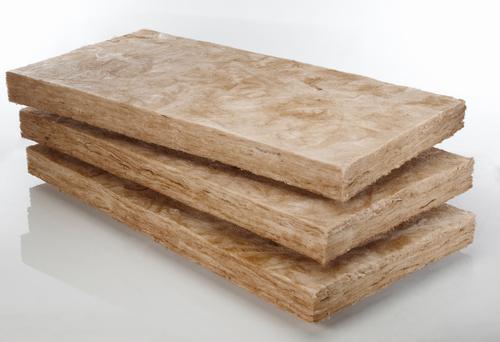

Basalt mineral wool: common uses
The naturalness and fire resistance of stone insulation made it very popular. The main application is insulation of building envelopes with basalt wool. These can be various roofs or facades. The special heat-insulating ability makes it possible to significantly reduce the heat loss occurring through the surfaces, as well as to keep the rooms cool during the hot seasons.
Areas of use:
- walls - in facade ventilated systems, light frame external structures or facades with different thickness of plaster;
- partitions - for soundproof purposes in partitions between rooms;
- floors - for the purpose of warming or soundproofing, on the overlapping plates;
- roofs - insulation can be laid on flat roofs on reinforced concrete slabs or corrugated board with subsequent waterproofing;
- insulation - used for pipelines and equipment, the property of incombustibility allows you to work with temperatures reaching 700 degrees.
Tips for choosing a material for a specific object
Today, basalt wool, the technical characteristics of which are so extensive that it is worth looking more narrowly, is used as a suitable insulation for a specific building. After all, the loads can be of a different nature, therefore, they study which ones affect a particular house or building. If, for example, bonded-type thermal insulation will be used on a building, then here it is necessary to choose plates from those that can withstand loads aimed specifically at breaking. When basalt wool will be used on flat areas of the roof, then it is worth paying attention to options that can withstand compression.
Application
- For insulation of ceiling or floor coverings, mats made of pressed basalt wool are suitable, walls are insulated with the same material, for further plastering or screed, or simply applied under decorative panels;
- The roll type is an excellent material for insulating piping systems from the effects of cold temperatures, if it is mounted on the surface, and not in the ground;

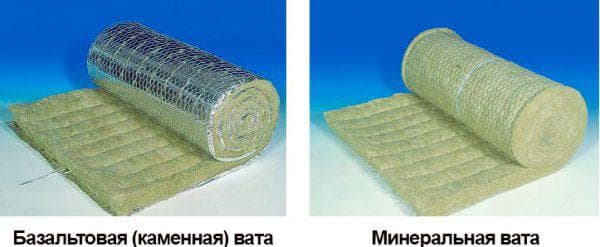
- The properties and density of basalt products allow for high-quality sound insulation of residential premises - the structure of microfibers perfectly absorbs all sounds coming from outside, therefore the thermal conductivity of stone wool and mineral wool is somewhat different;
- Arrangement of fire safety - cotton wool can only melt at too high a temperature, which is too difficult to create at home.
Material for places with high temperatures
There are also segmental parts, cylindrical and semi-cylindrical shapes, which are designed to provide thermal insulation protection of pipelines.
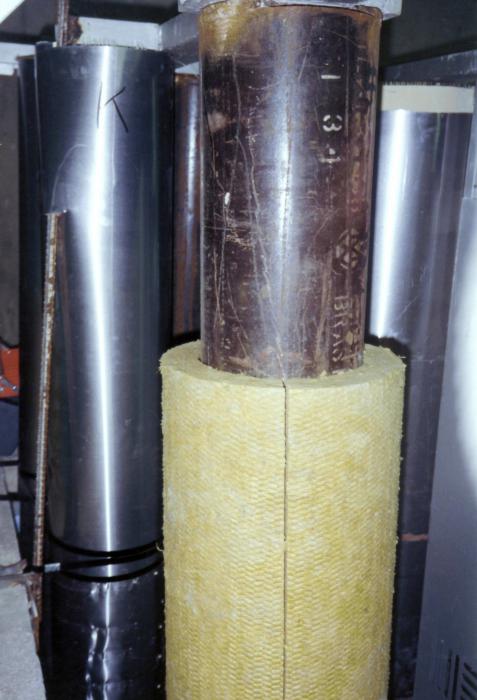

For places with high temperatures, it is also used. There is basalt wool for the chimney, its characteristics meet all fire safety requirements. In addition, it has a very low weight, this is its essential advantage when used in private homes. This insulation also has a water-repellent effect, which prevents condensation from forming on surfaces. Thanks to heat-resistant basalt wool, the chimney is less bulky, its weight is also minimal. However, all fire safety requirements remain at the highest level.
Methods of insulating structural elements of buildings
The area of use of basalt insulation is extensive, but we will briefly consider only the insulation of building structures.
Wall insulation from the inside
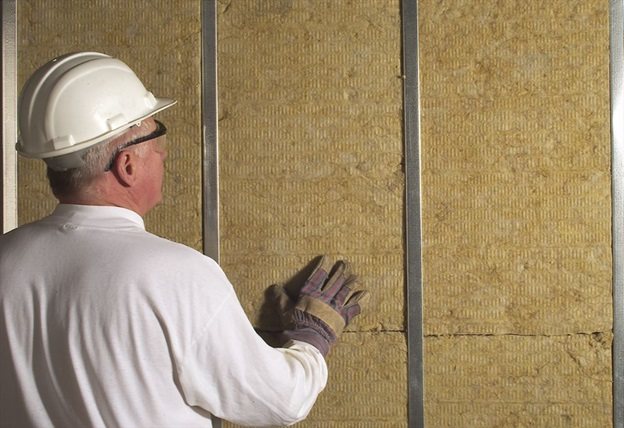

Thermal insulation of walls inside buildings with basalt wool
For effective insulation of wall structures with basalt wool indoors, it is recommended to arrange a vapor barrier, which is laid in the form of a special film over the insulation. It is imperative to make a ventilation gap between the vapor barrier material and the finishing of the walls. In this case, the moisture that comes from the premises will not be absorbed by the insulation. If you look at the insulated wall fragment in section, you can see the following layers:
- bearing wall;
- basalt wool;
- vapor barrier material;
- ventilated space;
- finishing finish.
Basalt wool with a density of 50 kg / m3 will work more efficiently if the facade is finished with materials that can allow moisture vapor to pass through.
Wall insulation outside


Insulation of the facade without the use of glue Considering the duration of the use of basalt wool, it is perfect for insulating the walls of buildings from the outside, if a material with a density of 80 kg / m3 is used. This can be a ventilated facade or wet wall plaster. A ventilated façade involves the use of guiding elements that are attached to the façade with strong dowels. When insulating this building structure, it is recommended to use a two-layer material. In this case, the layer with a lower density should be located against the wall. After that, a windproof film is installed, which is laid directly on the basalt wool. On top of the windscreen, additional guide strips are installed, which are designed to create a ventilated space between the insulation and the finishing material of the facade finish.
When plastering facades, mats are mounted on the walls with glue and additionally attached with special plastic dowels with a cap in the form of a fungus. Reinforcement mesh is laid on the mats and ordinary plaster is made.
Insulation of the floor, ceiling


To support the cotton wool are used - wire, fishing line, wooden slats
If the insulation is laid on the floor, there must be a waterproofing material under it. Especially if the insulation is carried out in a private house or on the first floor of multi-storey buildings. It is also imperative to mount a vapor barrier over the basalt wool. The vapor barrier can have a foil layer, in this case it is laid with the foil down, and on top with the foil up.
Not recommended instead of a special vapor barrier film, use a material that does not allow air and moisture vapor to pass through.
A ventilation gap of 4-5 cm must be maintained between the foil and the finishing floor covering. For insulation of the floor or ceiling, it is permissible to use material with a density not exceeding 35kg / m3.
Roof insulation


Insulation mats are inserted between the rafters at the edge
When insulating a roof, a material with a density of 40 kg / m3 is usually placed between the rafters. But a layer of waterproofing is pre-mounted. The mats should be chosen so that they are less than the height of the rafters by a couple of centimeters. The heat-insulating material is held by means of wooden slats, thick fishing line, nylon cord, which are attached to the rafters. A vapor barrier is spread over the supporting elements, and only then the finish is mounted.
What gives foil basalt wool
Now manufacturers produce similar heaters for various types of work that may be required in modern conditions. To ensure the maximum thermal insulation effect, there is foil basalt wool, which, due to its reflective surface, creates better results than ordinary wool.
This material is intended for thermal insulation of high-temperature units, stoves and fireplaces. In addition, it is excellent for cladding around appliances with a high temperature. Often, walls are glued with foil basalt wool to eliminate heat loss. This material cannot chemically react with other materials because it is inert. This feature makes it even more versatile.
Also, the coating is made of fiberglass, which gives the material high thermal insulation protection. It is most useful in ventilation systems to contain noise from mufflers.
Basalt slab manufacturers and models - what to choose?
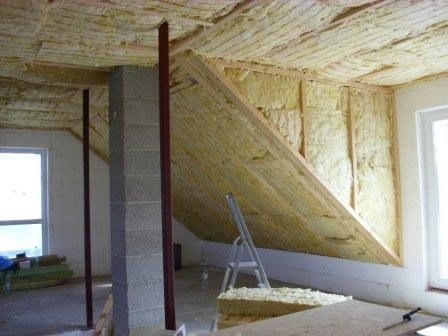

When choosing thermal insulation, it is recommended to take into account the characteristics of each model, the climate in the region, the technical properties of the insulated structure. Mineral wool from leading brands is sold in our store.
TechnoNIKOL. The Russian manufacturer is not inferior in quality to imported counterparts. The line includes:
- "Rocklight" for a flat pitched roof, interior arrangement of floors, walls, partitions;
- "Technoacoustic" - for sound insulation of residential, industrial buildings, equipment, pipelines;
- "Technolight" - to protect walls and partitions from blowing;
- "Technofas", "Technovent" - for facades for siding, plaster.
Rockwool. Another leader in the industry. Presented in several series:
- "Light Butts" - basalt insulation for walls, partitions, floors in houses;
- "Acoustic Butts" - sound insulation for home, industry;
- "Sauna Butts" - foil insulation with additional moisture protection;
- "Ruf Butts" - special plates for insulating roofs of various types;
- "Caviti Butts", "Facade Butts" are excellent options for insulating facades, curtain systems.
Isoroc. A high-quality domestic manufacturer, its most popular models are Isolight (mounted on a simple roof, attic, frame walls), Isoruf (for structures experiencing increased loads).
Izovol. Focused on interior improvement of premises.
The principle of operation of thermal insulation
Mineral wool is designed to generate heat in its chaotically collected fibers, and also muffle sounds. Branded counterparts, which were listed above, have such properties. However, it is worth choosing good professionals who can competently install this insulation. After all, if the craftsmen do the work badly, then even the Rockwool basalt wool, which is considered the best, will not fulfill its obligations.
Another important point is that the material itself is inside the body of the protective structure, and the functional component of the insulation also depends on how it is installed. It often happens that the installed basalt wool, the price of which is from 400 rubles for insulation for attics and up to 3000 rubles for a high-tech product with a foil coating that can withstand huge temperatures and their changes, does not withstand the load. The walls freeze in winter, and in the summer they begin to rot and become moldy. This can only mean one thing - the wizards installed everything incorrectly.
Types of basalt insulation
Basalt wool is produced with different densities, but different types of this material differ not only in this indicator. The main difference lies in its forms:
- roll;
- mat or plate;
- scattering.
The rolls use fiber with a diameter of up to 25 micrometers, the length of which is from 5 to 1500 mm.
For the production of mats, a fiber with the same parameters is taken.
Bulk basalt material obtained from coarse fibers with a diameter of up to 500 micrometers is used as a replacement for metal reinforcement using a binder.
There are mats in the structure of which two layers with different densities are used. A material is also produced, on one side of which a foil is glued, capable of reflecting both cold air currents and hot ones, thereby increasing the insulating characteristics of the material.
Benefits
- The thermal conductivity of basalt wool is the lowest among the rest of the insulation, which allows you to keep heat almost completely. His losses are negligible. When facing an object with basalt slabs, much less material is spent than when using other heaters.
- Does not deteriorate under the influence of aggressive environment and chemicals. This durability allows the material to remain in its original form both visually and functionally for many years.
- The manufacturer's warranty period is 30-40 years. However, builders claim that it is much longer, and one more, or even a couple of dozen, can be added to these numbers.
- It isolates very well any sounds, even very loud and harsh ones.In addition, the structure of basalt wool does not deteriorate over time from vibration. This is a significant plus over other heaters.
- UV, mold and mildew resistant.
- Easily withstands extremely high temperature fluctuations.
- Under no circumstances burns or explodes, absolute fire safety.
- Does not react with other materials and chemicals.
- Environmentally friendly material.
- Affordable price with the best quality.
Basalt insulation characteristics
The presented mineral wool is made from rocks - basalt and dolomite, melted at temperatures above 1500 degrees Celsius. The resulting fibers are stretched to form thin threads, glued together with environmentally friendly resins, laid in layers, forming air cavities.
Due to air chambers, basalt insulation has its own properties:
- Low thermal conductivity. Insulation prevents air convection, due to which heat is retained and does not escape.
- Noise isolation. The chaotic fibrous structure of the product absorbs extraneous sounds, allowing you to enjoy the silence.
- Moisture resistance. Basalt insulation is impervious to moisture, it repels water without losing its properties and does not allow it to penetrate into the internal structure of the material. For this reason, mineral wool is often used for finishing baths, saunas, swimming pools, and basements.
- Density. It can be different - from 25 to 200 kg / m3. The least dense material is intended for insulation of horizontal and inclined surfaces that do not experience additional stress (for example, a floor). Mineral wool with medium density is suitable for mounting on walls, in layered masonry, ventilation facades. The highest density is needed for arranging a flat roof. The higher the density, the lower the compressibility of the material and the more serious the load it can withstand.
- Non-flammability. Thermal insulation has a flammability class NG, can be heated up to 900-1000 degrees Celsius. Plates provide high refractoriness of the entire structure, and are also often used for the manufacture of an insulating layer in the design of devices and equipment.
- Biological stability. The material does not contribute to the development of fungus, mold, does not attract insects, rodents, does not contain harmful and hazardous chemical components.
- High vapor permeability. Moisture does not linger in the pores of the insulation. The absence of accumulated condensation has a positive effect on the durability of the building.
| Parameter | Value |
| Density | 40-225 kg / m³ |
| Elasticity | 68-75% |
| Thermal conductivity | λ = 0.033-0.46 W / (m × K) |
| Heat capacity | 500-800 J / kg * K |
| Fiber sintering temperature | 700-1000 ° C |
| Application temperature range | from -190 to +700 ° C |
| Peel strength of layers | 3-15 kPa |
| Tensile strength | 15 kPa |
| Compressive strength | 10-70 kPa |
| Compressibility, no more | 30% |
| Moisture by mass | 0,4–1,1% |
| Water absorption by volume | 1-5% |
| Water vapor permeability, not less | μ = 0.3 mg / (m × h × Pa) |
| Taunt | no |
| Sound absorption | 0.8-95 dB |
| Mass fraction of organic binder | 1-10% |
| Vibration resistance | weak or medium |
| Diameter | 5-15 microns |
| Length | 20-50 mm |
Differences and characteristics
This building insulation has special properties and technical parameters:
- High performance in sound insulation and heat insulation parameters;
- Meets all fire and refractory requirements and SNiP;
- High strength and durability - the material does not rot, shrink or shrink, remains unchanged for about 30 years;
- Excellent quality characteristics and vapor permeability - the wall of houses or the roof will breathe, that is, air exchange is established at a high level.
In the video, which insulation is better: basalt or mineral wool:
The strength of the insulation is given by the ability to resist and load microfibers of the material, the density indicator ranges from 30 to 100 kg / m³, it is these density parameters that set special characteristics for the stiffness and longevity of the insulation, it can serve for about 50 years in an unchanged form. But it is worth noting that the density of the mineral wool is even higher. Fibrous stone composition repels wet vapors, so it does not get wet and will always be dry, the specific gravity will always have a constant indicator. According to the technical characteristics, the hygroscopicity parameter is only 1%, therefore the thermal conductivity data remain in the range of 0.042–0.048 W / m3 K. Often, to figure out whether this material is suitable or not, the table of insulation characteristics helps.
The porosity of the insulation allows you to smooth out any mechanical effect of heavy objects, gusts of wind or hail, and also has excellent sound insulation performance due to its unique structure. Therefore, it is indispensable where the excess of sound signals from the outside is especially high.
It is also indispensable for buildings with a high degree of fire hazard - for arranging baths, fireplaces or traditional stoves, since the stone essence of basalt itself cannot ignite, but it can begin to melt if the temperature exceeds 1000 degrees Celsius.
But what technical characteristics of isover mineral wool exist, the information from this article will help to understand.
What is a roll of insulation with foil and how to use it correctly. can be seen in this video.
Which liquid thermal insulation materials for walls are the best and which ones to use are described in detail in this article.
But what materials to make thermal insulation of wooden walls from the outside is the easiest and most effective way, is described in this article.
What materials to insulate the walls from the outside, you can understand by clicking on the link.
Basalt wool: an assessment of the advantages and disadvantages
The advantages of using mineral insulation are indicated by its characteristics. The main advantages include: good thermal insulation properties, steam permeability, fire resistance, strength and environmental friendliness.
The disadvantages of basalt thermal insulation are:
- High cost. This is the main disadvantage of natural insulation. The price of a material is determined by its density and the manufacturer. It is worth noting that it is impossible to save money in choosing a brand - cheap offers often turn out to be of poor quality with the addition of toxic components.
- The presence of joints. At the joints of the plates, cold bridges... However, with proper installation, this problem can be minimized by tightly pressing the mats to each other and filling the cracks with foam.
- Dust during processing. It is advisable to carry out work in a respirator, since a dust cloud is formed when shaking and cutting the fibrous insulation.
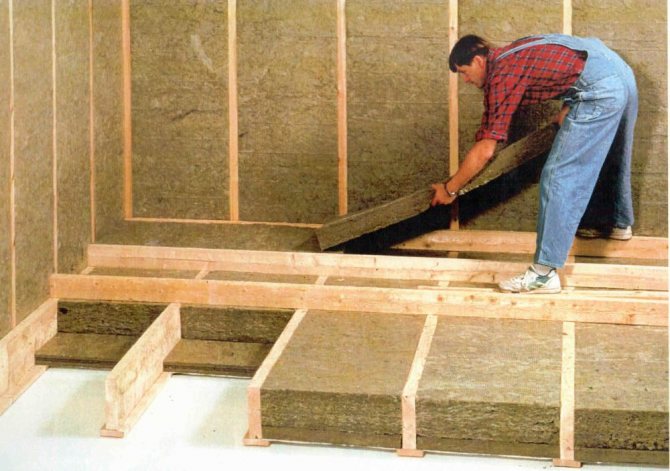

In certain cases, steam conductivity can be considered a minus. For example, it is better to use airtight polystyrene foam to insulate the foundation or basement.
Application in frame housing construction
Basalt slabs are actively used in frame housing construction. It is an excellent non-combustible insulation for walls and other structural elements. The choice of density is determined based on the direct purpose of thermal insulation:
- external wall insulation - slab thickness 100 mm, density - 80 kg / cu. m;
- insulation of interior partitions - enough material with a thickness of 50 mm, a density of 50 kg / cu. m;
- insulation with a density of 35 kg / m3 is suitable for ceilings and floors;
- thermal insulation of a sloped roof - mineral wool with a density of 40 kg / cu. m.
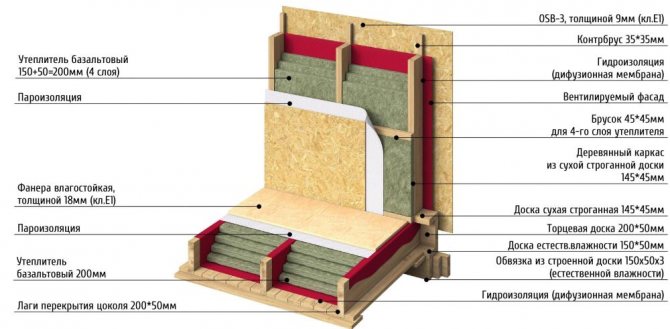

Basalt roll material and slabs serve as a reliable fire barrier, protecting building structures and ventilation ducts.
Useful: Izospan films and membranes (A, B, C, D, AM) - instructions for use


